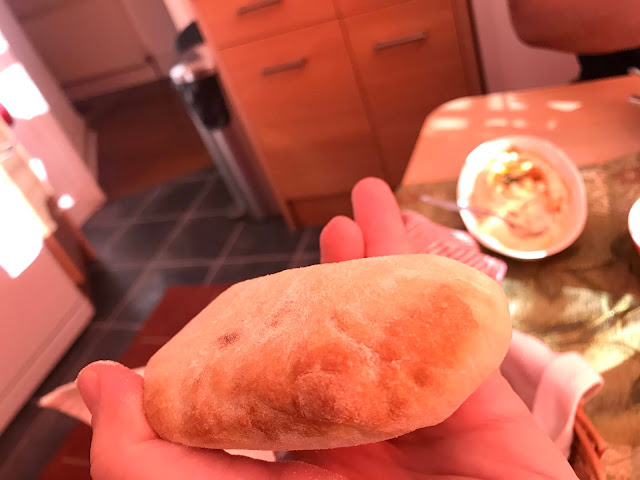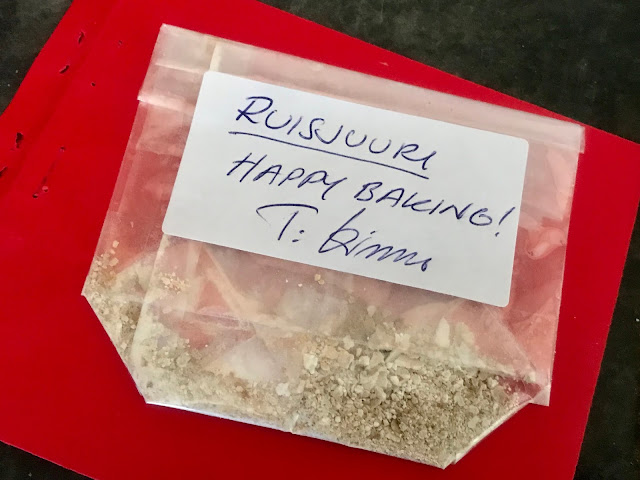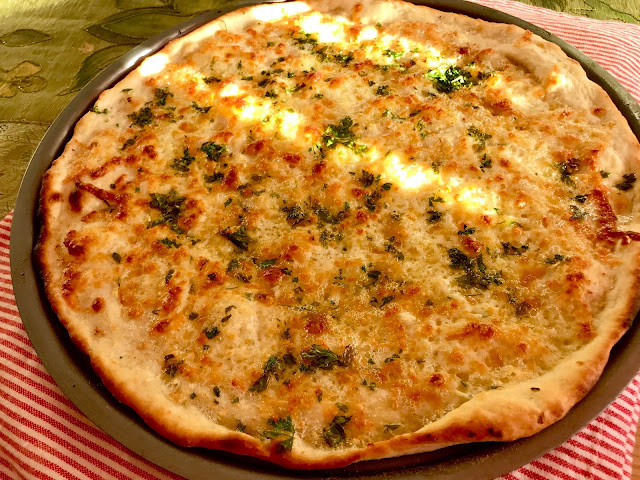 |
| The traditional Karelian pie or pasty, Rye dough filled with rice. |
This phenomenon is a bit surprising, since there has been no shortage of bread in shops. Or at least I think not, I actually haven't bought any bread since the beginning of lockdown because I fell into the baking trap on day one. I don't know why. It is partly to do with the fact that I now have time, because I don't have to commute or travel, but I think it probably is mainly because there is something fundamentally grounding and comforting in making your own bread. It's maybe a bit like growing your own veg. I just spoke to a colleague who was a bit baffled herself to find that she had felt the need to start growing beetroot as soon as she heard that her husband would be furloughed.
With all the baking I've been doing in the recent months I have even come to quite like kneading and I know that this in itself warrants a visit to a psychologist or some sort of therapy source. But something has happened to my hands, dough doesn't stick to my fingers anymore like it used to, I can actually produce springy elastic balls of dough which turn into loaves and buns and flatbreads that look and taste the way they were supposed to. The pitta-breads I baked the other night couldn't wait to obediently puff up into perfect little balls with pockets to stuff all sorts of nice Greek inspired things into.
 |
| There's a plump little pitta bread just waiting to be stuffed! |
Sometimes the texture has maybe been a bit denser than I aimed for and there was the occasion I moulded the slightly fussy Finnish rye sourdough into perfect wheel shapes and then realised I forgot the salt. So calmly and with just a few swearwords from the lighter end of the generous Finnish swearword repertoire I scooped it all back to the bowl, added the salt and shaped it back into perfect wheels.
And on another occasion for some reason the dough wouldn't rise with the power of the starter alone. After a couple of hours of patient waiting, I added some dried yeast to the mixture and they ended up being the most fantastic rye sourdough bread I have made so far.
The shortage of flour momentarily threatened my home-baking zeal, but thank God for eBay. I managed to procure some dry yeast from Bulgaria, rye flour from Poland and strong bread flour from a local bakery.
I have always thought that sourdough baking sounds like such a palaver because in the beginning you have to feed the starters daily or even a few times a day, and they sound temperamental and difficult to handle either exploding everywhere or producing foul smelling liquids. But actually it's like with puppies, they are more hassle early on, they eat shoes and cigarette butts, pee and poo everywhere, destroy the furniture and have to be fed all the time, but then, well actually dogs are a lot of work always, you can't just put them in the fridge and feed once a week.
So anyway I created my own sourdough starters in March. I made a wheat starter for French style rustic boules and batards using this recipe, there are lots of good recipes and instructions online. I also made a Finnish rye starter for my favourite kind of dark sourdough bread which you can't find in UK shops. And don't even mention the German pumpernickel stuff.
You are supposed to name your starters, they are living things after all, so I called my wheat starter Jean-Pierre after this French guy I know who wears a beret, a stripy T-shirt and a string of garlic around his neck. He travels around on a bike with the basket full of sourdough baguettes. My rye starter is called Tellervo after the beautiful maiden in our national epic Kalevala, and also a beloved ex-first lady of Finland who is also a bit on the sour and sarcastic side so the name is fitting to this pungent and biting little number.
With Tellervo I make the traditional whole rye wheel shaped flat round breads with a hole in the middle. In Finland we call them hole breads. After the hole you see, we are not complicated people. The breads were traditionally stored by inserting a wooden pole through the holes and then hung up near the ceiling to dry. I just put them in a plastic bag and store in a fridge. I find that a more practical approach.
A friend of mine saw my rye sourdough efforts in Facebook quite early on and sent me an envelope of dried 100 year old starter. This was hands down the best lockdown present anyone could ever give me apart maybe from the pack of toilet paper that a friend brought me in the early days.
The starter my friend sent me might be even much more than 100 years old. It comes from a farm that has belonged to the same family since 1300s, but they haven't been able to trace back the origins of the starter beyond sometime in the late 19th century. So I added some of this to Tellervo and have been baking with it ever since.
With Jean-Pierre I have produced several pretty boules getting better with the decoration and the structure as well as taste. I haven't got a proper lame, so a clumsy kitchen knife has had to do so far. I'm not much of a visual artist but I will try some different patterns just for the fun of it. And only recently I realised that the scoring is key to an airy structure as well as the starter itself, because it breaks the glutein of the surface and allows the loaf to expand. Logical!
It's kind of the reverse of me insisting to keep on wearing my skinny jeans for my lockdown office days instead of a pair of stretchy home pants in the hope that they will stop me from expanding. So far it's been more uncomfortable than successful.
 |
| Don't you just want to poke your finger in it! |
So here are the instructions for creating your own starter from scratch, much easier and more straight forward that you'd think. And also the recipe for best rye sourdough bread in the world. Best eaten fresh from the oven, but also great when reheated in the toaster. Finns eat it cold also, but I like the added crunch of toasting.
Never eat this bread with jam or honey. Ever. I'm still traumatised visiting an eastern European country with an English colleague of mine more than 15 years ago and recommending she try the excellent local sourdough rye bread at the hotel breakfast. She did and before I could say anything she'd spread the bread with strawberry jam and then said it wasn't really for her. Oh really?
Yeah I also don't like fish and chips with vanilla ice-cream.
This bread needs butter on top to begin with. Then top with gravadlax or smoked salmon, or cheese and cold cuts like smoked meats. Smoked reindeer would obviously be awesome. And a slice of tomato or cucumber for your perfect open sandwich the Finnish way.
Easy Finnish rye sourdough starter
Days 1 & 2
- Mix 100ml of warm water (about 30C degrees) and 125ml of rye flour in a bowl. Mix until smooth. Cover losely with a lid or tea towel. Place in a warm and draftless place, for instace sauna (!?!), unheated oven or microwave for 24 hours. (I just keep on a shelf on top of the cooker, because we keep our house quite warm.)
- On day 2 the mix has started to ferment and already has a mildly sour smell. Add the same amount of water and flour as day one. Mix well and continue to store in your warm place for another 24 hours.
Days 3 & 4
- On day three you can see bubbles in the mix and it has a stronger smell. Add the same amounts of flour and water and return to the warm place.
- On day 4 it should have bubbled properly. Now you start feeding the starter.
- Mix the starter and take 30g in a clean glass jar. Disgard rest of the starter. Feed the starter with 75ml of 30C water and 100ml of flour.
Days 5 & 6
- Repeat the feed (75ml water & 100ml flour) on day 5
- On day 6 the starter is light and bubbly and ready for baking.
Finnish sourdough rye bread (original recipe in Finnish)
Recipe makes 2 large loafs or 4 wheel shaped breads - I usually make with 500ml water and it makes enough for our small household, but this bread also freezes well)
900ml water
100ml rye sourdough starter
2-3 tsp salt
2kg rye flour (you won't need all, but the amount will depend on the type of flour)
2kg rye flour (you won't need all, but the amount will depend on the type of flour)
Mix the lukewarm water and the starter well. Add enough rye flour to create a thickish slurry. Cover with a tea towel and leave in a warm place, ideally around 25-30C for 24 – 48 hours. During the time mix a few times adding a little flour. Make sure your bowl is large enough, the mixture will bubble a lot.
Before you are ready to bake take some of the starter mixture and either store in the fridge if you bake often or in the freezer. Then go on to use the rest to make your dough. Add salt and enough rye flower to make the dough thick enough. Add flour little by little because they absorb water with a bit of delay and you don’t want the dough to get too thick and dry.
Before you are ready to bake take some of the starter mixture and either store in the fridge if you bake often or in the freezer. Then go on to use the rest to make your dough. Add salt and enough rye flower to make the dough thick enough. Add flour little by little because they absorb water with a bit of delay and you don’t want the dough to get too thick and dry.
Keep mixing with your hand until the dough just starts to separate from the edges of the bowl. It will not become elastic like a wheat dough and it will keep sticking to your fingers. Here’s a good Youtube video to understand what you are looking for in terms of thickness of the dough as well as shaping the breads. Unfortunately it is in Finnish, but you'll get the idea. You want to leave the dough a bit on the wet side, it will be more difficult to shape but will make better bread.
Once you are happy with your dough, smooth the surface and sprinkle with flower. With the side of your palm press a cross-shaped indent in the surface. This was traditionally done to "bless" the bread, but also to help determine when it was ready to shape. Leave covered in a warm draftless place to rise for 1-2 hours.
Once the cross has disappeared or almost disappeared depending on how deep you made the indent, the dough is ready to be shaped into breads. If you forgot to save some of the starter mixture, you can now take some of the dough (200ml) and keep this for the next time you want to bake. Again you can keep this starter in the fridge for up to one week, of you can freeze or dry it to keep it for up to several years.
Tip the dough onto a floured surface. A well-risen dough is airy, soft and sponge-like. Bring the dough together with both hands. Shape it into 2 round cone shaped loaves or 4 discs creating a hole in the middle with a small round glass or cookie cutter. Again the video gives you a better idea of how they should look.
You can also make individual portion sized breads by rolling the dough into small balls and then flattening them to about flat about 1-1.5cm discs.
Tip the dough onto a floured surface. A well-risen dough is airy, soft and sponge-like. Bring the dough together with both hands. Shape it into 2 round cone shaped loaves or 4 discs creating a hole in the middle with a small round glass or cookie cutter. Again the video gives you a better idea of how they should look.
You can also make individual portion sized breads by rolling the dough into small balls and then flattening them to about flat about 1-1.5cm discs.
Place the breads on baking trays that you have sprinkled with flour. I prefer not to use baking paper, because it will burn in the oven and make the fire alarm go off when I open the oven door. These breads won't rise anywhere as much as a wheat bread, but leave a bit of space between them particularly if you are baking loaves. Cover with tea towels and leave to rise for about an hour. Prick with a fork before baking.
Heat the oven to 225 - 250 °C. If you are baking loaves bake in 225-250C for about 20 minutes and then lower the temperature to 180 - 190C. Continue baking for another 40 minutes. Disc shaped thinner breads should be baked in 225 - 250C for 20 - 30 min, and individual small discs in 225-250C for about 20 minutes. Bread is done when they make a hollow sound when you tap the bottom. Leave to cool covered with tea towels.
But don't leave to cool for too long, it's best eaten warm while crust is still crunchy with butter on top.


















I bake my breads in a cast iron dutch oven. What is your take on using that method on the Finnish bread? Please talk to me if you find time. Thank you, - Margaret.
ReplyDeleteThat's how I bake my California-style sourdough, so I did it with my Finnish-style sourdough and it worked great!
DeleteThanks for the recipe! At the third bake they turned put perfectly. How long can the bread be stored at room temperature, without them drying out? Would you cover them (e.g. with cling film)? (I make small, single pieces, usually stored in the freezer and microwaved just before eating. Though, the freezer is quite small, so making a bigger batch gets problematic with that storage.)
ReplyDeleteOnce in a Danish television Programme, a Fin said they last as long as you are able to chew them.
DeleteIn a plastic bag in room temp probably 4-5 days, in the fridge a week and a bit. But slice up and freeze, straight to toaster from freezer and they are as good as freshly baked!
DeleteMorning when you’re doing the individual discs is there a weight amount to go by?
ReplyDelete